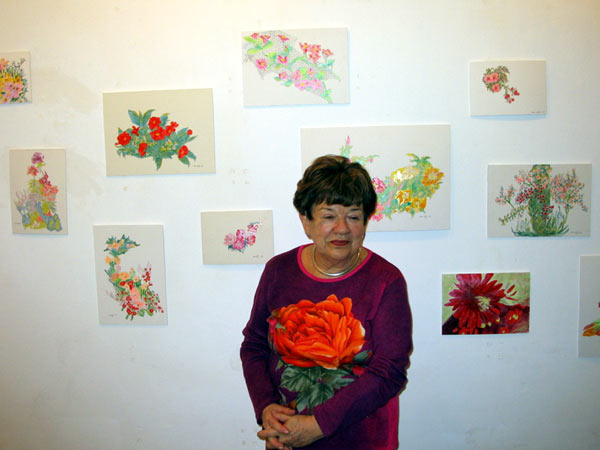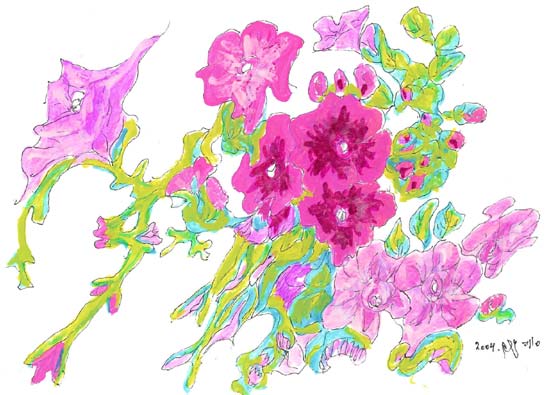.
.
.
.
.
.
.
.
.
.

Sonia Gurfein at the Opening
"The
superiority of the Flower over Man"
. . . .
![]() . . . .
6.01.05
>>30.01.05
. . . .
6.01.05
>>30.01.05

.
.
.
.
.
.
.
.
.
Who is
allowed to paint flowers? Only those who love them. But one may
examine other possibilities as well. Each artist has reasons of his own to
depict flowers obsessively.
Sonia Gurfein started painting flowers when she was five, a beautiful girl
with curly hair who lived in solitude with her mother and the neighbor with
whom they shared a kitchen. She loved that neighbor, for, unlike her mother,
the neighbor showed interest in her first painting – a vase of flowers.
Gurfein’s flower paintings are extracted as raw material from nature; they
are akin to a mirror image of her life, linking imagination to reality. At
times they portray species of perverse flowers that grew from her brush; at
others – flowers that have managed to hypnotize her and remain naive as in
children’s drawings.
It happened in moments of solitary communion with nature: Sonia, the
sketchbook, and the pencils set out to seek life’s little moments. Together
they share a secret, the pact of an eternal bond with life. Only death will
part them.
Until then, they meet in the backyard under the trees that reach the sky.
She reads the lights and the shadows constantly flickering on the parking
lot pavements. Later, they go to the public garden across busy Remez Street,
at the corner of Jabotinsky, near the ZZZ Café or opposite the historical
Herzliya Gymnasia. There, seated on one of the wooden benches, she tries to
find a good angle, pulling out the sketchbook from the used plastic bag. At
times she tears out a page, at others she does not. Taking off her
sunglasses, she picks a branch, and her mind fills with thoughts. Many days
she would go to that garden, for in front of the branches and flowers the
passion for another life is invoked in her.
The garden with its myriad sights does not satiate her. On the contrary, it
fills her with hunger for other flowers in different colors on the same
branch. She wishes to change what her eyes see, the order, the accuracy, and
imprint them with her personal mark, the impression of her artist signature.
The flowers are stimulating and she starts drawing them with black ink; with
swift painterly movements, she begins an imaginary dialogue with the shrub’s
branches and leaves. Her fingers hold the tip of the tool with which she
sails, sketches; and then she “feels like adding a branch or two, a flower,
a bud, an inflorescence – why not?” – Even though they are not there at all.
She wants them for her painting, she feels that it is important.
She returns home and says to herself: “Now I will breathe colorful life into
it,” and uses artificial means, such as varnish paints – yes, the very
polish Tel Aviv women apply to their nails. She sits by the improvised
worktable in the northeastern room of her apartment, rather than in the
studio in the city’s south, placing a rectangular plywood board on a small,
round Formica table that does not give much elbowroom for the act of
painting. Now she has created a 70x100 cm space for herself. On it she piles
scores of colorful and silvery polish bottles with ordinary brushes and some
other, ultra-thin brushes like those used by manicurists to skillfully paint
their customers’ nails, alongside painting papers, photographs of flowers,
reviews of painting exhibitions from the art sections of Ha’aretz, Ma’ariv
and Yedioth Ahronoth. Smadar Sheffi reviewing the exhibition Rose C’est La
Vie at the Tel Aviv Museum of Art, and reviews by Ruti Direktor in Tel
Aviv’s local paper, Ha’Ir, and Adam Baruch on Ma’ariv’s back page. There is
also acetone and cotton-wool and toilet paper and boxes filled with crayons
and pens of all colors, and felt-tip markers and fine brushes and plastic
bottle caps in which to mix the paints, and more papers on which to try the
paints instead of a plastic palette.
She takes all these out of the drawers of the wardrobe in the room. The
wardrobe’s doors appear like the facade of a black and white photograph of a
forest made of frayed wallpaper that was once new and the years have left
their mark on it. It is a terrible, blinding sight. The guest is advised to
sit with his back to the wardrobe and his face to the window. But Sonia
Gurfein no longer sees it. For her, its existence in the room in which she
paints is akin to that of the television, the chest of drawers, the bed, the
air-conditioner, and the chairs. She is surrounded by total mess and chaos,
constantly looking for something that was there a minute before. The
overflow of objects and furniture in all colors and styles is part of her
natural surroundings, ostensibly devoid of any discernible affinity to her
soul craving for the flowers.
Rachel Sukman